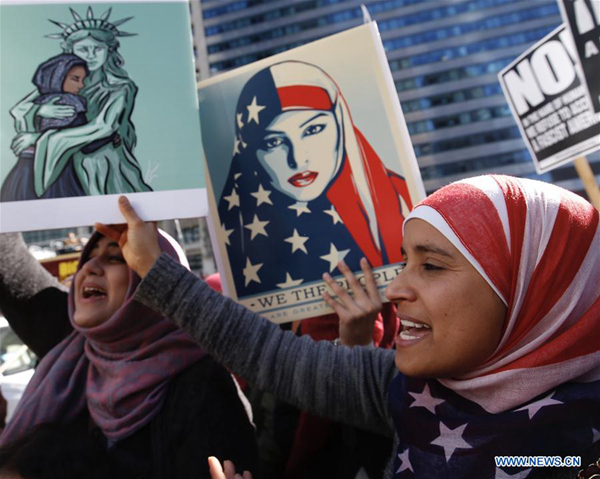President Trump's travel ban: biases on both sides
china.org.cn / chinagate.cn by Tom Zwart, February 21, 2017 Adjust font size:
|
|
|
Protesters hold placards to demonstrate against U.S. President Donald Trump outside Trump Tower in Chicago, the United States, on Feb. 19, 2017. (Xinhua/Jim Young) |
On Jan. 27 President Trump issued an executive order that bans entry into the U.S. by individuals from seven countries - namely Iraq, Iran, Libya, Somalia, Sudan, Syria and Yemen - for 90 days. It also suspends indefinitely the entry of all Syrian refugees into the country. The order has resulted in chaos at airports, mass protests at home and abroad, very negative media coverage and highly visible court cases.
The states of Washington and Minnesota challenged the executive order in a federal district court in Washington State. Their main objection was that professors employed by and students enrolled at state universities coming from these seven countries were no longer able to travel, while some were already stranded outside the U.S. The states claimed that the executive order violates the Constitution for two reasons. First, it restricts the ability of individuals to travel although they have neither received prior notification nor a hearing. Second, the intention of the order was to disfavor Muslims, which is contrary to the freedom of religion and equal protection clauses.
Since it will take some time before the court reviews the merits of the case, the states asked it to issue a temporary restraining order. This would suspend the enforcement of the order until a decision is taken. The court granted the temporary restraining order, and this was then challenged by the President before the Court of Appeals for the Ninth Circuit. Consequently, the appeal case only dealt with this temporary injunction, and not with the merits.
However, in order to decide whether the restraining order should remain in place, the court had to determine whether the President's order is likely to succeed based on its merits. In this way the main issues did play a role in the proceedings, but only indirectly. The court came to the conclusion that the President is likely to lose on the first point, regarding the lack of notice and a hearing prior to restricting the individual right to travel. Since that meant that the President is unlikely to succeed on the merits anyway, the court did not feel the need to tackle the second point, i.e. the complex and sensitive issue of religious discrimination.
The court stressed that while the states had demonstrated that reinstatement of the travel prohibitions would harm university professors and students, the President had failed to show that the U.S. would suffer irreparable injury if the injunction were to remain in place. The President claimed that the executive order was necessary to combat terrorism. But the court noted that the President had not succeeded in presenting any evidence that any alien from any of the countries named in the order has prepared a terrorist attack in the U.S.
The President might take the case to the Supreme Court. At first sight this looks like an attractive option, since the Supreme Court overturns 80 percent of the judgments of the Ninth Circuit, which has a very liberal reputation. However, at the moment, the Supreme Court is split 4:4 between conservatives and liberals, after conservative Justice Antonin Scalia died suddenly last year. If the court were to be divided on this case, the decision of the Ninth Circuit would stand. It is true that the President has nominated a conservative, Neil Gorsuch, to fill Scalia's seat, but the nomination will have to be approved by the Senate and that will take quite some time. Therefore, the President is considering alternative options, such as redrafting the order.
President Trump has been heavily criticized for issuing the order. But a lot of that criticism is political hyperbole: the restrictions regarding individuals from the seven countries actually builds on similar measures taken by the Obama administration that at the time nobody objected. Some are offended by the fact that the President called the district court judge a "so-called judge" and that he blamed the judges for jeopardizing national security. However, these comments are mild in comparison to the blunt criticism expressed by President Obama towards a judgment of the Supreme Court called Citizens United in 2010.
Nobody will deny that the President has the right and even the duty to protect the nation against terrorist attacks. However, he should do so without singling out or targeting Muslims. Muslims suffer a lot already from Islamophobia and the President of the U.S. should tackle rather than encourage it. Although the executive order is cast in neutral terms, during his campaign then Republican nominee Donald Trump referred to it as a "Muslim" ban. The Ninth Circuit rightly indicated that despite the neutral wording of the order the statements made by then candidate Trump may play a role in determining its meaning. If they do, the order is unlikely to survive.
Tom Zwart is a professor of cross-cultural law and human rights at Utrecht University.
Opinion articles reflect the views of their authors only, not necessarily those of China.org.cn
